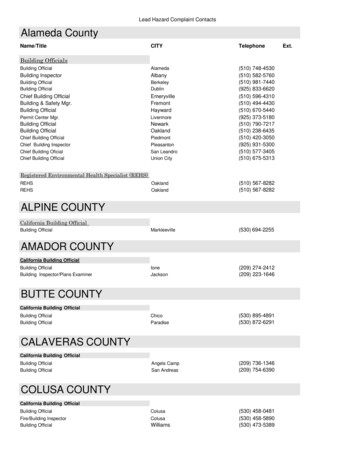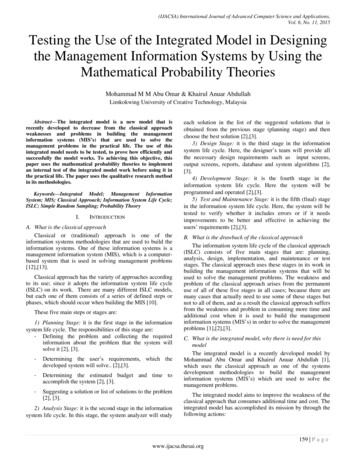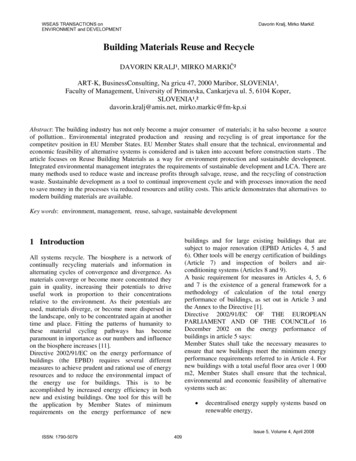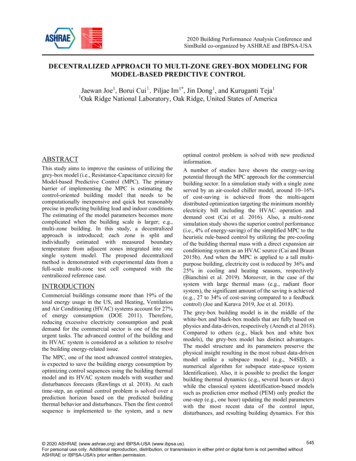
Transcription
ODYS: An Approach to Building a Massively-ParallelSearch Engine Using a DB-IR Tightly-Integrated ParallelDBMS for Higher-Level FunctionalityKyu-Young Whang† , Tae-Seob Yun† , Yeon-Mi Yeo† , Il-Yeol Song‡ , Hyuk-Yoon Kwon† , In-Joong Kim††Department of Computer Science, Korea Advanced Institute of Science and Technology (KAIST)Daejeon, Korea{kywhang, tsyun, ymyeo, hykwon, ijkim}@mozart.kaist.ac.kr‡College of Information Science and Technology, Drexel UniversityPhiladelphia, USAsongiy@drexel.eduABSTRACTsupporting the high-level (i.e., DBMS-level), SQL-like programming interface.Recently, parallel search engines have been implementedbased on scalable distributed file systems such as GoogleFile System. However, we claim that building a massivelyparallel search engine using a parallel DBMS can be anattractive alternative since it supports a higher-level (i.e.,SQL-level) interface than that of a distributed file systemfor easy and less error-prone application development whileproviding scalability. Regarding higher-level functionality,we can draw a parallel with the traditional O/S file systemvs. DBMS. In this paper, we propose a new approach ofbuilding a massively-parallel search engine using a DB-IRtightly-integrated parallel DBMS. To estimate the performance, we propose a hybrid (i.e., analytic and experimental)performance model for the parallel search engine. We arguethat the model can accurately estimate the performance ofa massively-parallel (e.g., 300-node) search engine using theexperimental results obtained from a small-scale (e.g., 5node) one. We show that the estimation error between themodel and the actual experiment is less than 2.13% by observing that the bulk of the query processing time is spent atthe slave (vs. at the master and network) and by estimatingthe time spent at the slave based on actual measurement.Using our model, we demonstrate a commercial-level scalability and performance of our architecture. Our proposedsystem ODYS is capable of handling 1 billion queries perday (81 queries/sec) for 30 billion Web pages by using only43,472 nodes with an average query response time of 194 ms.By using twice as many (86,944) nodes, ODYS can providean average query response time of 148 ms. These resultsshow that building a massively-parallel search engine usinga parallel DBMS is a viable approach with advantages ofCategories and Subject DescriptorsH.3.4 [Information Storage and Retrieval]: Systemsand Software—Performance evaluation (efficiency and effectiveness), Distributed systems; C.4 [Computer SystemsOrganization]: Performance of Systems—Measurement techniques, Modeling techniquesKeywordsmassively-parallel search engines, parallel DBMSs, DB-IRtight integration1. INTRODUCTION1.1 MotivationA Web search engine is a representative large-scale system, which handles billions of queries per day for a petabytescale database of tens of billions of Web pages [9, 19]. Untilnow, commercial Web search engines have been implementedbased on a scalable distributed file system such as GoogleFile System (GFS) [12] or Hadoop Distributed File System(HDFS) [16]. These distributed file systems are suitable forlarge-scale data because they provide high scalability usinga large number of commodity PCs. A storage system proposed for real-world scale data with better functionality isthe key-value store. It stores data in the form of a key-valuemap, and thus, is appropriate for storing a large amountof sparse and structured data. Representative key-valuestores are Bigtable [6], HBase [15], Cassandra [5], Azure [2],and Dynamo [11]. These systems are based on a large-scaledistributed storage such as a distributed file system [6, 15]or a distributed hash table(DHT) [2, 5, 11].However, both distributed file systems and key-value stores,the so-called “NoSQL” systems, have very simple and primitive functionality because they are low-level storage systems.In other words, they do not provide database functionality such as SQL, schemas, indexes, or query optimization.Therefore, to implement high-level functionality, developersneed to build them using low-level primitive functions. Research for developing a framework for efficient parallel processing of large-scale data in large storage systems has beenPermission to make digital or hard copies of all or part of this work forpersonal or classroom use is granted without fee provided that copies arenot made or distributed for profit or commercial advantage and that copiesbear this notice and the full citation on the first page. To copy otherwise, torepublish, to post on servers or to redistribute to lists, requires prior specificpermission and/or a fee.SIGMOD’13 June 22–27, 2013, New York, New York, USA.Copyright 2013 ACM 978-1-4503-2037-5/13/06 . 15.00.313
Community-limited searchproposed. MapReduce [8] and Hadoop [14] are the examplesof parallel processing frameworks. These frameworks areknown to be suitable for performing extract-transform-load(ETL) tasks or complex data analysis. However, they arenot suitable for query processing on large-scale data becausethey are designed for batch processing and scanning of thewhole data [27]. Thus, commercial search engines use theseframeworks primarily for data loading or indexing insteadof user query processing.High-level functionalities such as SQL, schemas, or indexes that are provided by the DBMS allow developers toimplement queries that are used in search engines easily because they provide a higher expressive power than primitivefunctions in key-value stores, facilitating easy (and much lesserror-prone) application development and maintenance. Inthis sense, there have been many research efforts to support SQL even in the NoSQL systems. Fig. 1 shows therepresentative queries used in search engines that can beeasily specified using the high-level functionality. Fig. 1 (a)shows a schema of a relation pageInfo that represents theinformation of Web pages. Fig. 1 (b) shows a SQL statementthat represents a keyword query. The query finds the Webpages that contain the word “Obama” from the pageInfo relation. Fig. 1 (c) shows a SQL statement that represents asite-limited search. Site-limited search limits the scope ofa user query to the set of Web pages collected from a specific site [29]. The query finds the Web pages that contain theword “Obama” from the site having siteId 6000. Fig. 1(d)shows one of its optimized versions. It requires an index-leveljoin operation on docId with text predicates involving contents and siteIdText attributes (see Fig. 4(a) in Section 2).Attribute RLcontentDescriptioninteger System defined identifierintegerPage identifierintegerSite identifiertextSite identifiertextPage titlevarcharPage URLtextPage content(a) pageInfo relation.Limited search: Search only within Linux communityTitle rom 2001-01-01 to(ex: from 2002-01-25 to 2002-01-30)(a) Advanced search with multiple fields.SELECT p.pageIdFROM page pWHERE MATCH(p.title, “database”) 0AND MATCH(p.content, “index”) 0AND MATCH(p.communityIdtext, “3”) 0AND p.reg date “2001-01-01”;(b) An SQL statement for an advancedsearch using attribute embedding.Figure 2: An example of advanced search.because it has higher scalability and performance than traditional single node DBMSs and also has rich functionality such as SQL, schemas, indexes, or query optimization.Stonebreaker et al. [27] argue that parallel DBMSs are scalable enough to handle large-scale data and query loads.They claim that parallel DBMSs are linearly scalable andcan easily service multiple users for database systems withmulti-petabytes of data. However, parallel DBMSs havebeen considered as not having enough performance and scalability to be used as a large-scale search engine [1, 8], oneoutstanding reason being the lack of efficient informationretrieval (IR) functionality.To enable a DBMS to efficiently handle keyword search,tight integration of database (DB) and information retrieval(IR) functionalities has been proposed [28, 29]. The tightDB-IR integration implements IR functionality within thecore of a DBMS, and thus, IR queries become efficient dueto short access paths to the IR functionality. Two techniquesfor providing DB-IR integrated queries also have been proposed: 1) IR index join with posting skipping [28, 29] and2) attribute embedding [29] to be explained in Section 2.1.2Our ContributionsIn this paper, we make the following three contributions.First, we show that we can construct a commercial-levelmassively parallel search engine using a parallel DBMS, whichto date has not been considered practical. Our proposed architecture, featuring a shared-nothing parallel DBMS, consists of masters and slaves. Our system, ODYS, followingthe proposed architecture achieves commercial-level scalability and efficiency by using Odysseus, which features DB-IRtight integration [28, 29], as its slaves. We have verified thateach Odysseus is capable of indexing 100 million Web pages(loading and indexing in 9.5 days in a LINUX machine1 ),and thus, ODYS is capable of supporting a large volumeof data with a small number of machines. Furthermore, theDB-IR tight integration enables the system to efficiently process a large number of queries arriving at a very fast rate.We show that ODYS can achieve a commercial-level performance especially for single-keyword searching, which is themost representative query.Second, we propose an analytic and experimental performance model (simply, a hybrid model ) that estimatesthe performance of the proposed architecture of the parallelDBMS, and then, validate the accuracy of the model. We argue that this model can accurately estimate the performanceof a massively-parallel engine using the experimental resultsobtained from a small-scale one. For the master and network, we model each system component using the queuingmodel, and then, estimate the performance. For the slave,we propose an experimental method for accurately predicting the performance of a scaled-out (e.g., 300-node) systemSELECT p.pageIdFROM pageInfo pWHERE MATCH(p.content, “Obama”) 0;(b) SQL statement for keyword searchSELECT p.pageIdFROM pageInfo pWHERE MATCH(p.content, “Obama”) 0AND p.siteId 6000;(c) SQL statement for site-limited search.SELECT p.pageIdFROM pageInfo pWHERE MATCH(p.content, “Obama”) 0 AND MATCH(p.siteIdText, “6000”) 0;(d) An optimized vertion of SQL statement for site-limited search.Figure 1: An example of a schema and SQL statements.These high-level functionalities allow us to easily developadvanced search engines with multiple search fields such ason-line discussion board systems as shown in Fig. 2 (a). Thepresented advanced search involves multiple fields as wellas community-limited search capability. It requires complexindex-level join operations among multiple fields, which require an implementation with high-level complexity. However, SQL allows us to implement those operations with asimple specification. Moreover, an index can be defined onany column by a simple declaration using SQL so that thesecomplex index-level joins on multiple columns can be processed efficiently. Fig. 2 (b) shows a simple SQL statementfor an advanced search that requires a four-way index-leveljoin on docId with text predicates involving title, content,communityIdText, and reg date attributes. Likewise, othersearch related applications can be easily developed by usingSQL.A parallel DBMS is a database system that provides bothstorage and parallel query processing capabilities. It couldbe considered an alternative to a large-scale search engine1The machine is with a quad-core 2.5 GHz CPU, 4 Gbytesof main memory, and a RAID 5 disk having 13 disks (disktransfer rate: avg. 83.3 Mbytes/s) with a total of 13 Tbytes,a cache of 512 Mbytes, and 512 Mbytes/s bandwidth.314
IR index of Odysseus [28]3 and MySQL are very close, butOdysseus has more sophisticated DB-IR algorithms for IRfeatures as discussed below.In a tightly integrated DB-IR system, an IR index is embedded into the system as shown in Fig. 3 (a). As in atypical DBMS, a B -tree index can be constructed for aninteger or formatted column. Similarly, an IR index is (automatically) constructed for a column having the text type.Fig. 3 (b) shows the structure of the IR index. The IR indexconsists of a B -tree index for the keywords, where eachkeyword points to a posting list. The leaf node of the B tree has a structure similar to that of an inverted index.Each posting list for a keyword consists of the number ofpostings and the postings for the keyword. A posting hasthe document identifier (docId), and the location information where the keyword appears (i.e., docId, offsets). Onthe other hand, distinct from the inverted index, the IR index has a sub-index [28]3 for each posting list to search fora certain posting efficiently.using a small-scale (e.g., 5-node) one. We note that the bulk(say, 92.28% 96.43%) of the query processing time is spentat the slave compared with the master and network. Ourexperimental method ensures high predictability of the slaveside query processing time (which contributes most of thetotal processing time) since the estimation is directly derivedfrom actual measurement. To verify the correctness of themodel, we have built a ten-node parallel system of the proposed architecture and performed experiments with queryloads compatible to those of a commercial search engine. Theexperimental results show that the estimation error betweenthe model and the actual experiment is less than 2.13%. Theproposed hybrid approach allows us to substantially reducecosts and efforts in building a large-scale system becausewe can accurately estimate its performance using a smallnumber of machines without actually building it.Last, by using the performance model, we demonstratethat the proposed architecture is capable of handling commercial-level data and query loads with a rather small number of machines. Our result shows that, with only 43,472nodes, ODYS can handle 1 billion queries/day2 for 30 billion Web pages with an average query response time of 194ms. We also show that, by using twice as many (i.e., 86,944)nodes, ODYS can provide an average query response time of148 ms. This clearly demonstrates the scalability and efficiency of the proposed architecture, and supports our argument that building a massively-parallel search engine usinga parallel DBMS can be a viable alternative with advantages such as the high-level (i.e., DBMS-level) and SQL-likeprogramming interface.The rest of this paper is organized as follows. Section 2 introduces techniques of DB-IR integration as a preliminary.Section 3 proposes the architecture of ODYS, a massivelyparallel search engine using a DB-IR tightly integrated parallel DBMS. Section 4 proposes the performance model ofODYS. Section 5 presents the experimental results that validate the proposed performance model and demonstrate thescalability and performance of ODYS. Section 6 concludesthe paper.B -tree indexIR index. . .textdata recordinteger(a) IR index embedding.a posting# postingsB -treedocID2, offsets.a posting list. . . keywordSub-index (for each posting list)docID1, offsets(b) Structure of the IR index.Figure 3: The IR index of the DB-IR tightly integrated DBMS.In the DB-IR tightly integrated DBMS, two methods areused to improve the search performance: IR index join withposting skipping [28, 29] and attribute embedding [29]. IRindex join with posting skipping is a technique for efficientlysearching documents (e.g., Web pages) that have multipleco-occurring keywords. To search for documents having cooccurring keywords, the posting lists of the keywords shouldbe joined. The posting skipping method identifies the partof the posting lists that need to be merged and skips therest by using sub-indexes [28]. Attribute embedding is a technique for efficiently processing a DB-IR query that joins anattribute of a structured data type and an attribute of thetext data type. For example, suppose that there are two attributes A and B having the text type and the integer type,respectively, and they are often accessed together. The attribute embedding method embeds the value of attribute Bin each posting of attribute A. In this case, a DB-IR querythat joins attributes A and B can be simply processed byone sequential scan of the posting list. In summary, it isthe tightly integrated IR features, such as the embeddedIR index with posting skipping, and attributed embedding,that makes ODYS a powerful search engine in the proposedparallel DBMS.Example 1. Fig. 4 shows the processing of an IR queryin a tightly integrated DB-IR system. Fig. 4 (a) shows anexample of IR index join with posting skipping. When a sitelimited query as in Fig. 1 (c) is given, siteIdT ext of typetext is used instead of siteId of type integer as in Fig. 1 (d).Thus, the postings to be merged from each posting list arefound efficiently using sub-indexes, as in the multiple keyword query processing. Fig. 4 (b) shows an example of attribute embedding. The values for siteId of type integer areembedded in the postings of Content. We can efficiently2. DB-IR INTEGRATIONIn the database research field, integration of DBMS withIR features (simply, DB-IR integration) has been studiedactively as the need of handling unstructured data as wellas structured data is rapidly increasing. There are two approaches to DB-IR integration: loose coupling and tight coupling. The loose coupling method—used in many commercial systems—provides IR features as user defined types andfunctions outside of the DBMS engine (e.g., Oracle Cartridge and IBM Extender). This method is easy to implement because there is no need to modify the DBMS engine,but the performance of the system gets degraded because oflong access paths to the IR feature. On the other hand, thetight coupling method [28, 29, 30] directly implements datatypes and operations for IR features as built-in types andfunctions of a DBMS engine (e.g., Odysseus [28, 29, 30] andMySQL [20]). The implementation of the method is difficultand complex because the DBMS engine should be modifiedbut the performance is accelerated. Thus, the tight couplingmethod is appropriate for a large-scale system to efficientlyhandle a large amount of data and high query loads. The2Nielsenwire [23] reports that Google handled 214 millionqueries/day in the U.S. in February 2010.3315Patented in the US in 2002; application filed in 1999.
process the queries involving both siteId and Content as inFig. 1 (c) by one sequential scan of the posting list.2ODYS processes a user query as follows. When a userquery arrives at a master, the master distributes the queryto all slaves. Then, the master merges the results returnedfrom the slaves and returns the final results to the user. Theslaves process the query and return the results to the master. Each slave returns top-k results in the ranking order,and the master performs a merge operation for the resultsreturned from the slaves to get the final top-k results. Theslaves store each posting list of the IR index in the PageRank order (i.e., we are using query-independent ranking) tomake top-k search efficient. Since the posting lists are storedin the PageRank order, the query processing performance isnot much affected regardless how long the posting lists areor how big the database is. In this paper, we focus on theperformance issues of the search engines and not on the effectiveness of ranking results. For performance reasons, weuse query-independent ranking, which can be computed inadvance, as many large-scale commercial search engines do,but any other ranking methods can be applied8 .SubindexKeyword“Obama”.Index forattribute“content”Keyword“6000”Index oc35doc49doc50doc30doc32doc38.doc49Posting listdoc10doc11doc14doc15Subindex(a) Posting Skipping.doc1Index forattribute“content”Posting lista 300doc224200.doc259000.(b) Attribute Embedding.siteIDFigure 4: IR query processing in a tightly integratedDB-IR system [29].3. ODYS MASSIVELY-PARALLEL SEARCHENGINE3.1 ArchitectureFig. 5 shows the architecture of ODYS. ODYS consists ofmasters 4 and slaves 5 . The masters share the slaves, andthe slaves have a shared-nothing architecture. Each slaveis Odysseus storing data in a disk array. The master andthe slaves are connected by a gigabit network hub, and theycommunicate by using an asynchronous remote procedurecall (RPC)6 .Parentprocessdisk arrayLAN card1.Hub1.Slave nsOdysseusDBMSShared bufferDisk1.LAN cardnhHubnh.Slave1.Child(async. calls)Slave(nh - 1) ns 1nhnh.Updates and Fault ToleranceIn this paper, we focus on the performance issues of thesearch engine. Thus, we only briefly mention update andfault tolerance issues.Updates and concurrency control: The search enginesshould handle a tremendous number of concurrent queries,which mostly consist of read-only transactions. Thus, inthis paper, we focus on read-only transactions and the needfor locking can be obviated9 . Nevertheless, ODYS supportsupdates on a per-node basis with strong consistency [30];thus, any transaction pertaining to individual nodes can beproperly handled [29]. Update transactions can be processedon dedicated nodes and the nodes on service can be replacedwith the updated nodes periodically.Fault tolerance: Currently, fault tolerance features arebeing implemented in ODYS. We adopt an approach similar to the one proposed in Osprey [31]. In Osprey, Yang etal. [31] proposed a method implementing MapReduce-stylefault tolerance functionality in a parallel DBMS. The proposed method maintains replicas and allocates small sizedtasks dynamically to the nodes according to the loads of eachnode. As in Osprey, availability and reliability are achievedby maintaining multiple replicas of ODYS, and a middlewarecan be used for dynamically mapping masters and slaves ofthe multiple ODYS replicas. We call a replica of ODYS anODYS set.ODYS Parallel-IR MastermachineOdysseusDBMS3.2Slavens.DiskwFigure 5: The architecture of ODYS.The master stores metadata such as slaves’ IP addresses,slaves’ database paths (i.e., the location of the disk devicestoring each slave database), and schemas. The slaves storecrawled Web pages and their IR indexes. There are two wellknown methods for partitioning the index [9]: 1) partitioningby documents and 2) partitioning by keywords. For performance reasons, most commercial search engines includingGoogle use the former method [9], which makes slaves workin parallel for processing the same query. Thus, we also employ the same method. That is, the entire set of Web pages ispartitioned horizontally. Each slave stores a segment of thepartitioned data and creates an IR index for each text-typeattribute in the segment. To build a scalable shared-nothingparallel DBMS, we store tables into slaves in such a way toavoid a cross-node join. In search engines, typically there isone large-scale table, namely, the one for Web pages (say,227 TBytes) and many small-scale tables (say, 1 GBytes)such as tables for schema information, site information, anddatabase statistics. We partition only the large-scale tableinto slaves and duplicate small-scale tables in every slave7 .3.3Other Parallel Processing SystemsIn this section, we discuss the architectural relationshipsbetween ODYS and other recently developed parallel processing systems. We classify the existing DFS-based systems and parallel DBMSs into four types of layers as shownin Fig. 6 10 . In Fig. 6, the storage layer represents a distributed storage for large-scale data. The key-value storeor a table layer represents a data storage storing data in8Most commercial search engines use PageRank as a baseranking measure, and additionally, combines the querydependent ranking (e.g., TF-IDF). However, since querydependent ranking is only applied only to the top resultsthat have been retrieved based on query-independent ranking [25], its processing cost is somewhat limited.9Locking can be switched off in the search engine mode byselecting the consistency level 0.10Modified and extended from the figure in p.4 of [4].4The ODYS Parallel-IR Master consists of 58,000 lines of Cand C code.5The Odysseus (slave) consists of 450,000 lines of C andC code.6We use socket-based RPC consisting of 17,000 lines of C,C , and Python code developed by the authors.7In this design, if two or more large-scale tables were used,join operations among those tables would not be allowed.316
the form of key-value pairs or records in tables. The parallel execution layer represents a system for automaticallyparallelizing the given job. The language layer represents ahigh-level query interface.SQL-like SQL-likeLanguageSawzalllayerParallelMapexecution ReducelayerPigSQL-likeHiveDryad(Yahoo!) (Facebook) LINQ Scope Hadoopcenter or an academic institute to build a real-world scalesearch engine because of limited resources including availability of hardware, space, and manpower. Therefore, anelaborate analytic or experimental model is needed to testand project the performance and scalability of a large-scalesystem without actually building it. For massively-parallelprocessing systems, analytic models using the queuing theory have been proposed to estimate the performance of thesystems [17, 26]. However, those analytic models cannot besimply applied to our architecture because of the followingreasons. First, the existing methods use simple parameters.In practice, however, to accurately estimate the performanceof a large-scale system, all the specific parameters related tothe performance of the system should be identified. Second,the existing methods assume that there is only one querytype, while we consider multiple types of queries. Last, asthe phenomenon that most significantly affects the performance, we show that the query response time is boundedby the maximum among slaves’ query processing times, butno existing analytic method takes this into account. Therefore, we propose a performance model based on the queuingtheory as well as intricate measurement schemes.We claim that our performance model using a small-scalereference system (i.e., 5-node) can quite accurately predictthe performance of a large-scale system (i.e., 300-node) dueto the following reasons12 . The performance model consistsof two parts: 1) the master and network time and 2) theslave time. We show that the estimation error of the formeris quite low, i.e., maximum 10.15% as shown in Fig. 11 inSection 5.2.2. Moreover, even if the estimation error of themaster and network time were sizable, it could not affectthe overall performance in a significant way since the overallperformance largely depends on the performance of the slavetime (e.g., 96.43% for 15.5 million queries/day) as shown inFig. 14. We can be assured that the estimated performanceof slaves is very close to the actual measurement since theestimation is directly derived from the measurement as presented in Section 4.2. Thus, our estimation of the totalquery response time is quite accurate (e.g., the estimationerror is less than 2.13%) as shown in Fig. 11.The assumptions related to query execution are as follows.We assume that every query is a top-k query where k is oneof 10, 50 or 1000, and the set of input queries is a mix ofsingle-keyword queries, multiple-keyword queries, and limited search queries as will be explained in Section 4.1.1.To evaluate a lower-bound performance of our system, wetake two very conservative assumptions: 1) we run ODYSat “semi-cold start” and 2) we wait until “all” the slaves return the results. First, semi-cold start means that a queryis executed in the circumstance where the internal nodes ofthe IR indexes (which normally fit in main memory) are resident in main memory while the leaf nodes (which normallyare larger than available main memory), posting lists, andthe data (i.e., crawled Web pages) are resident in disk. Typical commercial search engines process queries at warm startby storing the entire (or a large part of) indexes and dataTo ey-valuestore or Bigtable Hbasetable layerCassandra(Facebook)Postgre rGFS GoogleHDFSApacheCosmosMSS3LocaldiskHDFSLocaldisk& KAIST Yahoo! KAISTAmazon YaleBrown (Odysseus(ODYS)(HadoopDB) /DFS)DFS-based systemsParallel DBMSsFigure 6: The map of ODYS and other parallel processing systems.Most DFS-based systems that have been recently developed follow or modify Google’s architecture. DFS-based systems developed by Apache and Microsoft (MS) have an architecture very close to Google’s. On the other hand, Amazon’s Dynamo and HadoopDB can be considered as variations of Google’s architecture. Dynamo has a fully decentralized architecture and uses a relaxed consistency modelcalled eventual consistency. HadoopDB has a hybrid architecture of the DFS-based system and the DBMSs; it isHadoop on top of multiple single-node DBMSs. PNUTS isa highly scalable parallel DBMS that provides carefully chosen functionalities. It shares some design choices with theDFS-based system in that it provides simple functionalities,a relaxed consistency model, and flexible schema.ODYS consists of two layers: Odysseus and Odysseus/Parallel-IR. The Odysseus corresponds to the table layer.In ODYS, Odysseus DBMSs with local disks are used inparallel rather than key-value stores with a DFS system.The Odysseus/Parallel-IR is an integrated layer that combines the parallel execution layer and the language layer.Because ODYS uses a DBMS for the table layer, it can provide rich functionality for query processing by directly usingmost DBMS features including SQL.There are several open source projects for search engines.Solr and Nutch are parallel search engines based on ApacheLucene [21], which is a search engine library for a singlemachine. They have a similar architec
†Department of Computer Science, Korea Advanced Institute of Science and Technology (KAIST) Daejeon, Korea {kywhang, tsyun, ymyeo, hykwon, ijkim}@mozart.kaist.ac.kr ‡College of Information Science and Technology, Drexel University Philadelphia, USA songiy@drexel.edu ABSTRACT Recently, parallel search engines have been implemented










